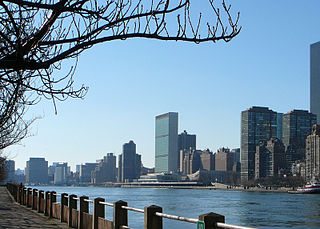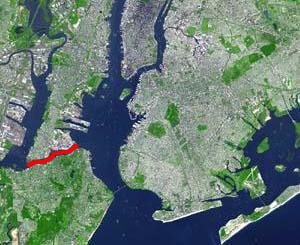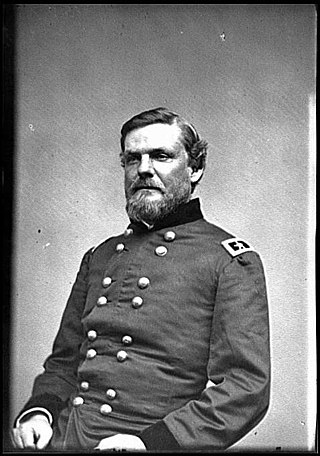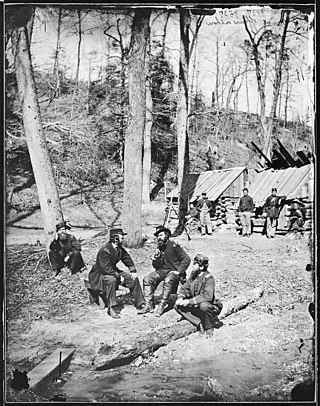

Hell Gate is a narrow tidal strait in the East River in New York City. It separates Astoria, Queens, from Randall's and Wards Islands in Manhattan. [1]


Hell Gate is a narrow tidal strait in the East River in New York City. It separates Astoria, Queens, from Randall's and Wards Islands in Manhattan. [1]
The name "Hell Gate" is a corruption of the Dutch phrase Hellegat . It first appeared on a Dutch map as Helle Gadt. [2] The name was originally applied to the entirety of the East River, by Dutch explorer Adriaen Block, the first European known to have navigated the strait, who bestowed the name sometime during his 1614–1616 voyage aboard the Onrust circumnavigating Long Island, from its namesake Hellegat on (the mouth of) the River Scheldt, in Zeeland back in the Netherlands. [3] [4] [lower-alpha 1]
This name Hellegat was taken from the Greek Hellespont (Dardanelles) which also has a dangerous reputation, in the opinion of historian Edward Manning Ruttenber. [4] Alternatively, the name could be construed to mean "bright strait" or "clear opening", according to geographer Henry Gannett. [6]
Because explorers found navigation hazardous in this New World place of rocks and converging tide-driven currents (from the Long Island Sound, Harlem River strait, Upper Bay of New York Harbor, and lesser channels, some of which have been filled), the Anglicization stuck. [7]
The strait was also known as Hurl Gate (or Hurlgate), and so labeled on 18th and 19th century maps and annals, [8] [4] this name probably consisting of Dutch warrel 'whirl' and gat 'hole, gap, mouth', in effect denoting 'whirlpool'. [4]
For the whirlpool that develops in Hell Gate, the name Monatun was applied by Dr. Henry Rowe Schoolcraft; the name is said to mean "violent, forcible, dangerous". [4]
In October 1776, Admiral Howe sailed some of the British fleet through the strait, an action which was considered reckless at the time. [9]
Hell Gate was spanned in 1917 by the New York Connecting Railroad Bridge, now called the Hell Gate Bridge, which connects Wards Island and Queens. The bridge provides a direct rail link between New England and New York City. [10] In 1936, it was spanned by the Triborough Bridge (now the Robert F. Kennedy Bridge), allowing vehicular traffic to pass among Manhattan, the Bronx, and Queens. [11]

Periodically, merchants and other interested parties would try to get something done about the difficulty of navigating through Hell Gate. In 1832, the New York State legislature was presented with a petition for a canal to be built through nearby Hallet's Point, thus avoiding Hell Gate altogether. Instead, the legislature responded by providing ships with pilots trained to navigate the shoals for the next 15 years. [12]
In 1849, a French engineer whose specialty was underwater blasting, Benjamin Maillefert, had cleared some of the rocks which, along with the mix of tides, made the Hell Gate stretch of the river so dangerous to navigate. Ebenezer Meriam had organized a subscription to pay Maillefert $6,000 to, for instance, reduce "Pot Rock" to provide 24 feet (7.3 m) of depth at low-mean water. While ships continued to run aground (in the 1850s about 2% of ships did so) and petitions continued to call for action, the federal government undertook surveys of the area which ended in 1851 with a detailed and accurate map. [12]
By then Maillefert had cleared the rock "Baldheaded Billy", and it was reported that Pot Rock had been reduced to 20.5 feet (6.2 m), which encouraged the United States Congress to appropriate $20,000 for further clearing of the strait. However, a more accurate survey showed that the depth of Pot Rock was actually a little more than 18 feet (5.5 m), and eventually Congress withdrew its funding. [13]
With the main shipping channels through The Narrows into the harbor silting up with sand due to littoral drift, thus providing ships with less depth, and a new generation of larger ships coming online – epitomized by Isambard Kingdom Brunel's SS Great Eastern, popularly known as "Leviathan" – New York began to be concerned that it would start to lose its status as a great port if a "back door" entrance into the harbor was not created. [14] In the 1850s the depth continued to lessen – the harbor commission said in 1850 that the mean water low was 24 feet (7.3 m) and the extreme water low was 23 feet (7.0 m) – while the draft required by the new ships continued to increase, meaning it was only safe for them to enter the harbor at high tide. [15]
The U.S. Congress, realizing that the problem needed to be addressed, appropriated $20,000 for the Army Corps of Engineers to continue Maillefert's work, but the money was soon spent without appreciable change in the hazards of navigating the strait. An advisory council recommended in 1856 that the strait be cleared of all obstacles, but nothing was done, and the Civil War soon broke out. [16]

In the late 1860s, after the Civil War, Congress realized the military importance of having easily navigable waterways, and charged the Army Corps of Engineers with clearing Hell Gate of the rocks there that caused a danger to navigation. The Corps' Colonel James Newton estimated that the project would cost $1 million, as compared to the approximate annual loss in shipping of $2 million. Initial forays floundered, and Newton, by that time a general, took over direct control of the project. [16] In 1868 Newton decided, with the support of both New York's mercantile class and local real estate interests, to focus on the 3-acre (1.2 ha) Hallert's Point Reef off of Queens. The project would involve 7,000 feet (2,100 m) of tunnels equipped with trains to haul debris out as the reef was eviscerated, creating a reef structured like "swiss cheese" which Newton would then blow up.
After seven years of digging seven thousand holes, and filling four thousand of them with 30,000 pounds (14,000 kg) of dynamite, on September 24, 1876, in front of an audience of people including the inhabitants of the insane asylum on Wards Island, but not the prisoners of Roosevelt Island – then called Blackwell's Island – who remained in their cells, Newton's daughter set off the explosion. The effect was immediate in decreased turbulence through the strait, and fewer accidents and shipwrecks. The city's Chamber of Commerce commented that "The Centennial year will be for ever known in the annals of commerce for this destruction of one of the terrors of navigation." Clearing out the debris from the explosion took until 1891. [17] [18] [19] [20]
Newton had begun to undermine Flood Rock, a 9-acre (3.6 ha) reef, even before starting on Hallert's Rock, removing 8,000 cubic yards (6,100 m3) of rock from the reef. In 1885 Flood Rock was blown up as well, [21] with Civil War General Philip Sheridan and abolitionist Henry Ward Beecher among those in attendance. Newton's daughter once more set off the blast, the biggest ever to that date and subsequently reported as the largest man-made explosion until the advent of the atomic bomb [17] [18] [19] although the detonation at the Battle of Messines in 1917 was several times larger.[ citation needed ] Two years later, plans were in place to dredge Hell Gate to a consistent depth of 26 feet (7.9 m). [22]
In James Fenimore Cooper's historical fiction novel The Water-Witch, or, The Skimmer of the Seas (first published in New York in 1830 [24] ), Hell Gate serves as the scene for an exciting pursuit of the brigantine Water Witch by HMS Coquette. [25] [26] The Water Witch is captained by Thomas Tiller, an adventurous sailor with a romantic flair, and HMS Coquette by Captain Cornelius van Cuyler Ludlow, a principled young officer in the Royal Navy and a native of New York.

The East River is a saltwater tidal estuary or strait in New York City. The waterway, which is actually not a river despite its name, connects Upper New York Bay on its south end to Long Island Sound on its north end. It separates Long Island, with the boroughs of Brooklyn and Queens, from Manhattan Island and from the Bronx.

San Francisco Bay is a large tidal estuary in the U.S. state of California, and gives its name to the San Francisco Bay Area. It is dominated by the cities of San Francisco, San Jose, and Oakland.

The Golden Gate is a strait on the west coast of North America that connects San Francisco Bay to the Pacific Ocean. It is defined by the headlands of the San Francisco Peninsula and the Marin Peninsula, and, since 1937, has been spanned by the Golden Gate Bridge. The entire shoreline and adjacent waters throughout the strait are managed by the Golden Gate National Recreation Area.

Marble Hill is the northernmost neighborhood in the New York City borough of Manhattan. Although once part of Manhattan Island, it is now one of the few areas of Manhattan that are not located on the island. The Bronx surrounds the neighborhood to the west, north, and east. The area of Marble Hill was established as a Dutch colonial settlement in 1646, and gained its current name in 1891 from the Tuckahoe marble deposits discovered underneath the neighborhood.

New York Harbor is at the mouth of the Hudson River where it empties into New York Bay near the East River tidal estuary, and then into the Atlantic Ocean on the East Coast of the United States.

The Hell Gate Bridge is a railroad bridge in New York City, New York, United States. The bridge carries two tracks of Amtrak's Northeast Corridor and one freight track between Astoria, Queens, to Port Morris, Bronx, via Randalls and Wards Islands. Its main span is a 1,017-foot (310 m) steel through arch across Hell Gate, a strait of the East River that separates Wards Island from Queens. The bridge also includes several approach viaducts and two spans across smaller waterways. Including approaches, the bridge is 17,000 feet (5,200 m) long. It is one of the few rail connections from Long Island, of which Queens is part, to the rest of the United States.

The Arthur Kill is a tidal strait in the New York–New Jersey Harbor Estuary between Staten Island, New York and Union and Middlesex counties, New Jersey. It is a major navigational channel of the Port of New York and New Jersey.

The Kill Van Kull is a tidal strait between Staten Island, New York and Bayonne, New Jersey in the United States. It is approximately 3 miles (4.8 km) long and 1,000 feet (305 m) wide and connects Newark Bay with Upper New York Bay. The Robbins Reef Light is at the eastern end of the Kill, and Bergen Point marks its western end. It is spanned by the Bayonne Bridge and is one of the most heavily traveled waterways in the Port of New York and New Jersey.

Adriaen Courtsen Block was a Dutch private trader, privateer, and ship's captain who is best known for exploring the coastal and river valley areas between present-day New Jersey and Massachusetts during four voyages from 1611 to 1614, following the 1609 expedition by Henry Hudson. He is noted for possibly having named Block Island, Rhode Island, and establishing early trade with the Native Americans, and for the 1614 map of his last voyage on which many features of the mid-Atlantic region appear for the first time, and on which the term New Netherland is first applied to the region. He is credited with being the first European to enter Long Island Sound and the Connecticut River, and to determine that Manhattan and Long Island are islands.

The Bronx Kill is a narrow strait in New York City delineating the southernmost extent of the Bronx. It separates the Bronx from Randalls Island. It connects the Harlem River to the East River.

Spuyten Duyvil Creek is a short tidal estuary in New York City connecting the Hudson River to the Harlem River Ship Canal and then on to the Harlem River. The confluence of the three water bodies separate the island of Manhattan from the Bronx and the rest of the mainland. Once a distinct, turbulent waterway between the Hudson and Harlem rivers, the creek has been subsumed by the modern ship canal.

Newtown Creek, a 3.5-mile (6-kilometer) long tributary of the East River, is an estuary that forms part of the border between the boroughs of Brooklyn and Queens, in New York City. Channelization made it one of the most heavily-used bodies of water in the Port of New York and New Jersey and thus one of the most polluted industrial sites in the United States, containing years of discarded toxins, an estimated 30,000,000 US gallons of spilled oil, including the Greenpoint oil spill, raw sewage from New York City's sewer system, and other accumulation from a total of 1,491 sites.

John Newton was a career officer in the United States Army, a Union general in the American Civil War, and Chief of the Corps of Engineers.

The geography of New York City is characterized by its coastal position at the meeting of the Hudson River and the Atlantic Ocean in a naturally sheltered harbor. The city's geography, with its scarce availability of land, is a contributing factor in making New York the most densely populated major city in the United States. Environmental issues are chiefly concerned with managing this density, which also explains why New York is among the most energy-efficient and least automobile-dependent cities in the United States. The city's climate is temperate.

Professor Benjamin S. H. Maillefert was an engineer who specialized in underwater blasting. He developed torpedoes used by the Union naval forces during the American Civil War.

The draft or draught of a ship's hull is the vertical distance between the waterline and the bottom of the hull (keel). The draught of the vessel is the maximum depth of any part of the vessel, including appendages such as rudders, propellers and drop keels if deployed. Draft determines the minimum depth of water a ship or boat can safely navigate. The related term air draft is the maximum height of any part of the vessel above the water.
Sears Rock is a small sub-surface rock about 0.7 miles (1.1 km) west of Rodeo Beach in the Pacific Ocean off Marin County, California. It is the highest point of the larger Centissima Reef, a sub-surface navigation hazard east of the Bonita Channel, although some reports refer to the two as separate features.

A gat is a strait that is constantly eroded by currents flowing back and forth, such as tidal currents. It is usually a relatively narrow but deep, up to 30 m (100 ft) passage between land masses or shallow bars in an area of mudflats. A gat is sometimes a shallower passage on lagoon coasts, including those without any tidal range.

The Newtown Creek Wastewater Treatment Plant is the largest sewage treatment facility operated by the New York City Department of Environmental Protection. Since 2010, its eight metallic "digester eggs", which are 140 feet tall and dramatically illuminated with blue light at night, have made it a local landmark, particularly to motorists on several nearby roadways in the New York City boroughs of Brooklyn, Queens, and Manhattan. It is located on the Newtown Creek in Brooklyn's Greenpoint neighborhood along Greenpoint Avenue.

The removal of obstructive rocks from Hell Gate, a narrow tidal strait in New York City's East River and a major water transportation route, began in 1849, when French engineer Benjamin Maillefert, cleared some of the rocks. Then in 1851, the U.S. Army Corps of Engineers, led by General John Newton, began to do the job, in an operation which was to span 70 years. On September 24, 1876, the Corps used 50,000 pounds (23,000 kg) of explosives to blast the rocks, which was followed by further blasting. The process was started by excavating under Hallets reef from Astoria. Cornish miners, assisted by steam drills, dug galleries under the reef, which were then interconnected. They later drilled holes for explosives. A patent was issued for the detonating device. After the explosion, the rock debris was dredged and dropped into a deep part of the river. This was not repeated at the later Flood Rock explosion.
Informational notes
Citations
Bibliography